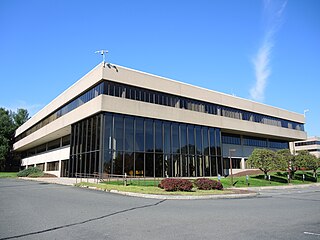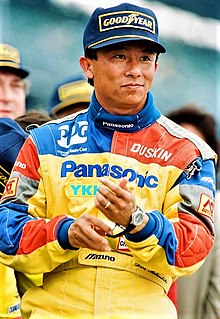
Panasonic Corporation, formerly known as the Matsushita Electric Industrial Co., Ltd., is a Japanese multinational consumer electronics corporation headquartered in Kadoma, Osaka.
Total quality management (TQM) consists of organization-wide efforts to "install and make permanent climate where employees continuously improve their ability to provide on demand products and services that customers will find of particular value." "Total" emphasizes that departments in addition to production are obligated to improve their operations; "management" emphasizes that executives are obligated to actively manage quality through funding, training, staffing, and goal setting. While there is no widely agreed-upon approach, TQM efforts typically draw heavily on the previously developed tools and techniques of quality control. TQM enjoyed widespread attention during the late 1980s and early 1990s before being overshadowed by ISO 9000, Lean manufacturing, and Six Sigma.
National was a brand used by Panasonic Corporation to sell home appliances, personal appliances, and industrial appliances. Neither National Semiconductor nor National Car Rental are related to Panasonic or the "National" brand.
Kōnosuke Matsushita was a Japanese industrialist who founded Panasonic, the largest Japanese consumer electronics company.

Frank Julian Sprague was an American naval officer and inventor who contributed to the development of the electric motor, electric railways, and electric elevators. His contributions were especially important in promoting urban development by increasing the size cities could reasonably attain and by allowing greater concentration of business in commercial sections. He became known as the "Father of Electric Traction".
United Technologies Corporation (UTC) was an American multinational conglomerate headquartered in Farmington, Connecticut. It merged with the Raytheon Company in April 2020 to form Raytheon Technologies. It researched, developed, and manufactured products in numerous areas, including aircraft engines, aerospace systems, HVAC, elevators and escalators, fire and security, building automation, and industrial products, among others. UTC was also a large military contractor, getting about 10% of its revenue from the U.S. government. Gregory J. Hayes was the CEO and chairman.

Otis Worldwide Corporation is an American company that develops, manufactures and markets elevators, escalators, moving walkways, and related equipment.

Emerson Electric Co. is an American multinational corporation headquartered in Ferguson, Missouri, United States. The Fortune 500 company manufactures products and provides engineering services for a wide range of industrial, commercial, and consumer markets. Emerson has approximately 76,500 employees and 205 manufacturing locations worldwide.
An elevator pitch, elevator speech, or elevator statement is a short description of an idea, product or company that explains the concept in a way such that any listener can understand it in a short period of time. This description typically explains who the thing is for, what it does, why it is needed, and how it will get done. Finally, when explaining an individual person, the description generally explains one's skills and goals, and why they would be a productive and beneficial person to have on a team or within a company or project. An elevator pitch does not have to include all of these components, but it usually does at least explain what the idea, product, company, or person is and their value.
Shigeo Shingo, born in Saga City, Japan, was a Japanese industrial engineer who was considered as the world’s leading expert on manufacturing practices and the Toyota Production System.
George Alfred Lawrence David is the former Chairman and Chief Executive Officer of United Technologies Corporation. David was elected UTC’s President in 1992 and Chief Executive Officer in 1994. He joined UTC’s Otis Elevator subsidiary in 1975 and became its President in 1986.

Carrier Global Corporation is an American corporation based in Palm Beach Gardens, Florida. Carrier was founded in 1915 as an independent company manufacturing and distributing heating, ventilating and air conditioning (HVAC) systems, and has since expanded to include manufacturing commercial refrigeration and foodservice equipment, and fire and security technologies.
Japanese management culture refers to working philosophies or methods in Japan. It included concepts and philosophies such as just in time, kaizen and total quality management.

Hiroyuki "Hiro" Matsushita, is a former driver in the Champ Car, Formula Atlantic series who won the Toyota Atlantic Championship (Pacific) in 1989 as a first and only Japanese. He is the grandson of Konosuke Matsushita, founder of Panasonic. He is also the first Japanese driver to race at the Indy 500.His father Masaharu Matsushita who served as the second President of Panasonic for sixteen years beginning in 1961. His elder brother Masayuki Matsushita is the current Vice Chairman of Panasonic. His relationship has allowed him to receive financial backing from Panasonic throughout his racing career.
Toru Takasuka is a Japanese software entrepreneur.
Human performance technology (HPT), also known as human performance improvement (HPI), or human performance assessment (HPA), is a field of study related to process improvement methodologies such as lean management, Six Sigma, lean Six Sigma, organization development, motivation, instructional technology, human factors, learning, performance support systems, knowledge management, and training. It is focused on improving performance at the societal, organizational, process, and individual performer levels.
Meedan is a non-profit social technology company which aims to increase cross-language interaction on the web, with particular emphasis on translation and aggregation services in Arabic and English. Through its use of Machine Translation (MT), Machine Augmented Translation (MAT), and distributed human translation, Meedan’s goal is to increase dialogue and exchange between Arabic and English speakers primarily by launching a cross-language forum for conversation and media sharing. This service will be designed to stand as “a digital gathering place for a linguistically, culturally, and geographically diverse community of Arabic and English speaking Internet users”.
Hamilton Sundstrand was an American globally active corporation that manufactured and supported aerospace and industrial products for worldwide markets. A subsidiary of United Technologies Corporation, it was headquartered in Windsor Locks, Connecticut. The company was formed from the merger of Hamilton Standard and Sundstrand Corporation in 1999. In 2012, Hamilton Sundstrand was merged with Goodrich Corporation to form UTC Aerospace Systems. In 2018, UTC Aerospace Systems and Rockwell Collins combined to form Collins Aerospace.
Sullair is a major manufacturer of portable and stationary rotary screw air compressors designed for commercial and industrial use. Founded in 1965 in the town of Michigan City, Indiana U.S.A., Sullair has manufacturing facilities in Michigan City that distribute and service air compressor packages and systems worldwide. Sullair also has manufacturing facilities in Suzhou, Jiangsu and Shenzhen, Guangdong China that service the Asian and Australasian markets. Sullair also has offices in Dandenong South, Australia near Melbourne, and in Sunderland, United Kingdom that services markets in the EMEA and Russia.
Raytheon Technologies Corporation is an American multinational conglomerate headquartered in Waltham, Massachusetts, United States. The company is one of the largest aerospace and defense manufacturers in the world by revenue and market capitalization. It researches, develops, and manufactures advanced technology products in the aerospace and defense industry, including aircraft engines, avionics, aerostructures, cybersecurity, missiles, air defense systems, and drones. The company is also a large military contractor, getting a significant portion of its revenue from the U.S. government.





